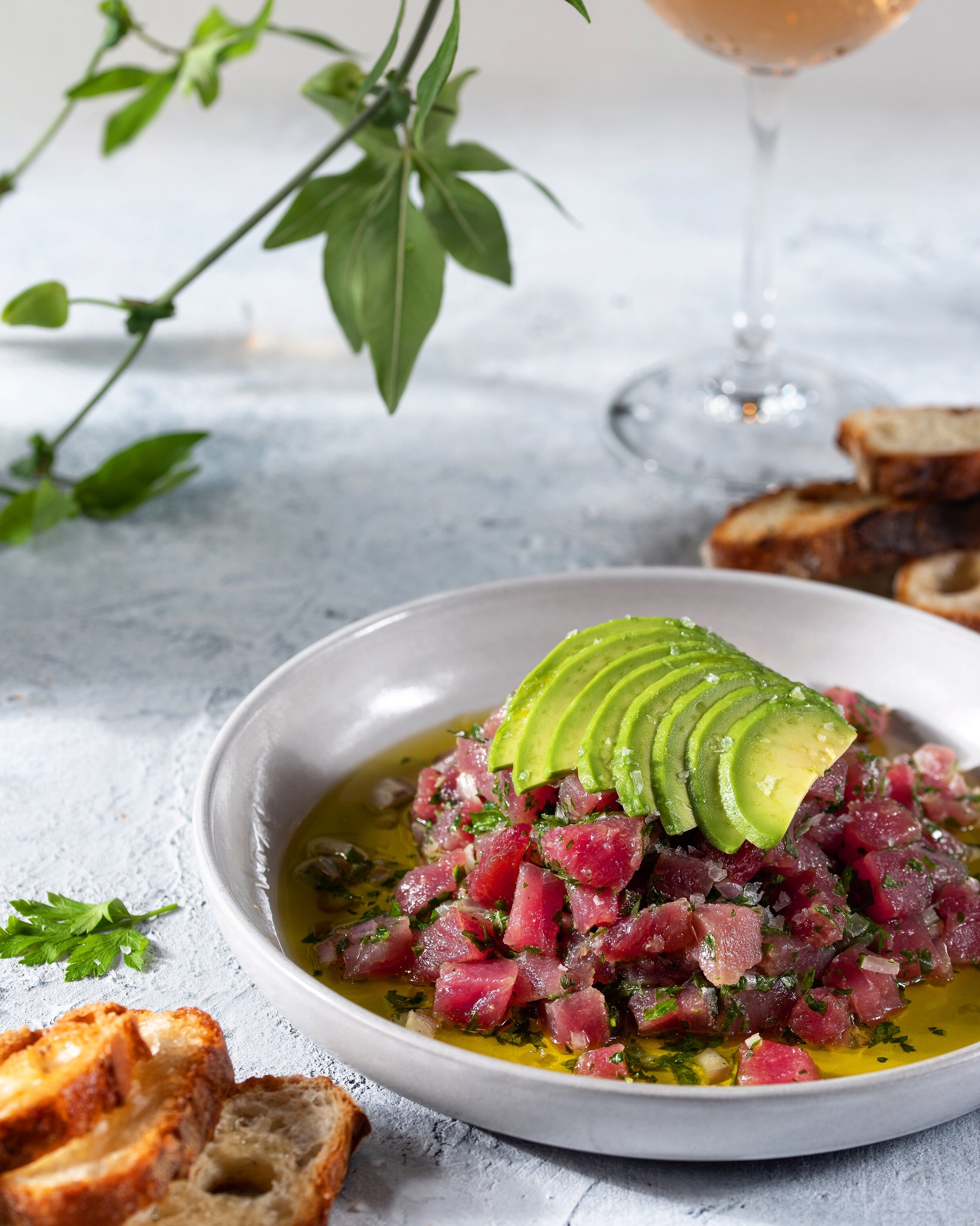Raw Fish
A dash of good quality olive oil, a generous squeeze of lime juice, a sprinkle of finishing salt - sometimes it’s the simplest of ingredients that creates the masterpiece.
I’m a minimalist at heart, and I believe it was for this reason that my love affair with raw fish began. I love that you can take something so simple and easy and dress it up in a million different ways. I love how it becomes a blank canvas to test my own creativity and never-ending curiosity with flavors & textures. Lingering notes of umami paired with bright pops of zest and that perfect balance of heat and acid come together to hit every note on your palate.
We all love ordering raw fish at upscale restaurants, but eating those dishes is no longer reserved for the high end restaurant consumers and unapproachable chef-like home cooks. With a few rules, great ingredients, and a sharp knife, you’ll begin to learn that it’s a lot easier than it looks!
When it comes to raw fish, it’s more about understanding the underlying components then it is about learning a recipe. Master this, and raw fish will no longer be an intimidating task but an exciting way to test your own creativity in the kitchen!
On these sweltering summer days, when it’s too hot to fire up the grill or turn on the oven, something raw, fresh, and light is exactly what you’ll be making.
Here is everything you need to know!
Importance of Quality Ingredients
Buying raw fish can be a little daunting, especially if you’ve never done it before. If you’re going to spend a lot on pricey ingredients, you want to make sure that what you’re getting is not just good quality, but also safe to consume. So here are some factors to keep in mind:
What is Sushi Grade?
Dispelling the myth:
Many people mistakenly assume that sushi or sashimi grade means that the fish has been flash frozen prior to being sold and therefore doesn’t contain bacteria. This is incorrect. Sushi grade, called sashimi grade in the industry, refers to the quality of the fish and not its health risk, which means that not all sashimi grade fish has been flash frozen. The term “sashimi grade” only refers to specific standards of freshness, i.e. appearance, presentation, texture, and taste. Sashimi grade fish will have a higher fat content, less sinew, great color, and overall better texture and flavor. So when buying sashimi grade fish from your fishmonger, you are likely getting the top quality fish available (what they refer to as Grade A), so although it was not necessarily previously frozen, it is still safe to be eaten raw.
Buying from the right source:
At the end of the day, every fish store has different levels of quality. The important thing is to know your fishmonger or market. Go to a reputable store that understands quality, with quick turnover and a knowledgeable staff that can help you make better decisions. The prepackaged salmon at your supermarket isn’t going to cut it!
What to ask for:
Always begin by asking your fishmonger what is freshest, and let him know you plan to eat it raw. (Ask for the skin to be removed, to save yourself that trouble!) Starting a conversation will help him steer you towards what you’re looking for. He may not have fresh salmon today, but maybe the tuna or fluke is looking great! Instead of walking in with an exact recipe, let the quality of the fish dictate your choices. Quality and freshness is more important then an ingredient list, and in many recipes, the fish is interchangeable. Here are three ways to help you discern freshness:
Smell: Sashimi grade fish should not smell fishy in any way. It should have a slight hint of the ocean, but should be otherwise odorless! If it smells fishy, don’t eat it raw.
Color: Fish should have no discoloration or yellow edges. Fresh fish should be slightly shiny and vibrant; it shouldn't look dull or be discolored in any way.
Flesh: The muscle of fresh fish should be tight, firm, and smooth, with no gaps or separations in the flesh. When pressed, it should bounce back. Soft, grey, or inelastic fish is old or bad.
Eyes: If buying whole fish, you want to ensure the eyes are bulging and shiny. Eyes of old fish are cloudy and sunken into the head.
How to safely store it:
Buying the fish on the day you’ll eat it is always ideal - but let’s be honest, that’s not always doable. So here’s how to store it to ensure maximum freshness:
Remove fish from the bag and discard any paper it was sold in.
Pat dry with a paper towel to remove excess moisture.
Wrap fish in clean, dry parchment paper and place in tightly sealed zip lock bag.
Fill a shallow dish with ice and lay the fish on top, then store in the coldest part of your refrigerator. Refresh ice as needed. Use within two days.
Quick Cure
Quick curing fish uses salt to draw out moisture through the process of osmosis. This process helps firm up and remove water from the fish, resulting in a better texture and enhanced flavor. For a quick cure, salt the fish and leave in the fridge for 30 minutes to an hour before slicing and dressing it. This does not mean the fish has been cured, so keep in mind that it is still considered completely raw. I do this with all fish besides tuna, which already has a great texture and low moisture content. This step can be done on the day you eat it, or as soon as you bring it home. If you cure it prior to the day you’re eating it, just drizzle with a little olive oil and store as suggested above.
You’ve got your fish, now what?
When working with very simple raw fish dishes, the quality of your ingredients makes a significant difference when it comes to the finished product, from the quality of the fish all the way down to the oil and salt. Raw fish has a delicate, mild flavor, so in order to create a balanced dish that hits every point on your palate, every component needs to add subtle flavor and texture. This is how you achieve depth and interest in a dish that might otherwise fall flat. Understanding these components will enable you to get creative instead of constantly relying on a recipe.
OIL: Use an oil that has body and flavor. A good quality olive oil will add that perfect hint of flavor and fat that brings the whole dish together.
VEGETABLES: Stick with seasonal produce to add contrasting flavors and textures to your fish. Sliced radish or cucumber adds beautiful crunch as well as color - make sure to shave it thinly so it doesn’t overpower the delicate fish!
FRUIT: Using fruit can add that subtle sweetness a savory dish might need. I love the combination of salmon and apples!
HERBS AND AROMATICS: A sprinkle of herbs adds that layer of freshness, earthiness and overall pop that ups your flavor profile.
ACID and ZEST: A finish of lemon or lime zest over raw fish adds a beautiful hint of brightness and acidity without overwhelming the delicate fish.
HEAT: Adding a kick of heat really spices things up. A little diced jalapeno or a dash of sriracha in the dressing goes a long way.
SALT: A good quality finishing salt such as flaky Maldon salt adds that mild saltiness that you need without overpowering your delicate fish. It also adds a layer of great texture and crunch.
Utensils needed
How to Slice it
Crudo
If working with salmon, trim away the thin fatty area first.
With a sharp chef’s knife, slice the fish along the spine into two equal parts.
Take each piece and gently slice into ¼” even slices.
Keep in mind that you don’t want to hack at the fish - two even glides should do it.
Tartare and Poke
Using a very sharp knife, trim away any sinew or skin from the tuna fillet.
Cut the tuna into 1 ½” inch slices
Take the slices and cut into long strips.
Rotate the strips and slice into ¼” cubes.
*It should be noted that all raw fish, sashimi grade or not, can contain bacteria and parasites, even if it was previously frozen. The FDA recommends that all pregnant women avoid eating raw fish.
This article is dedicated in loving memory of Reb Berel Raskin A”H who served fish to his community and well beyond, for almost 60 years. His warmth and smile will always be remembered by the thousands who knew him!















